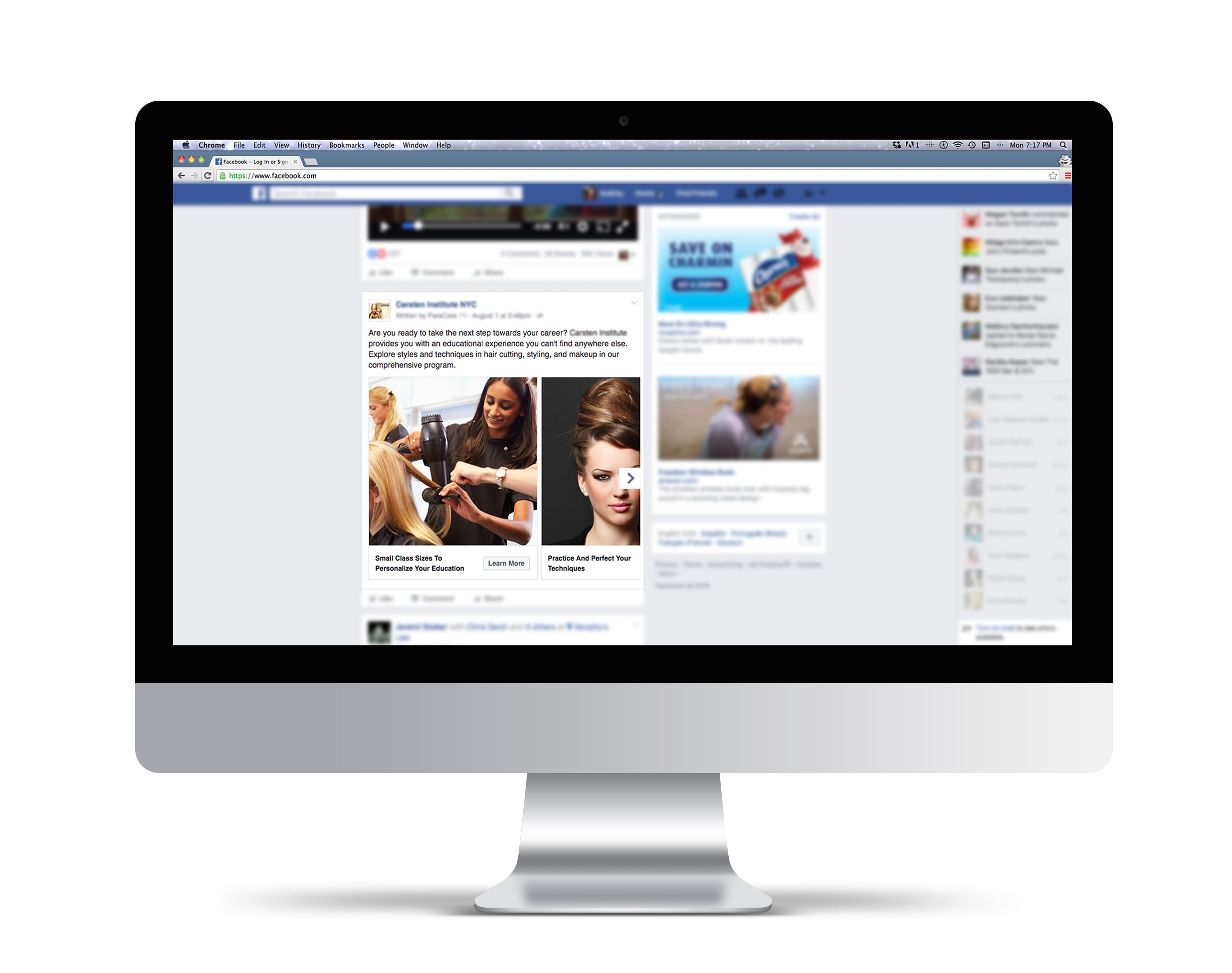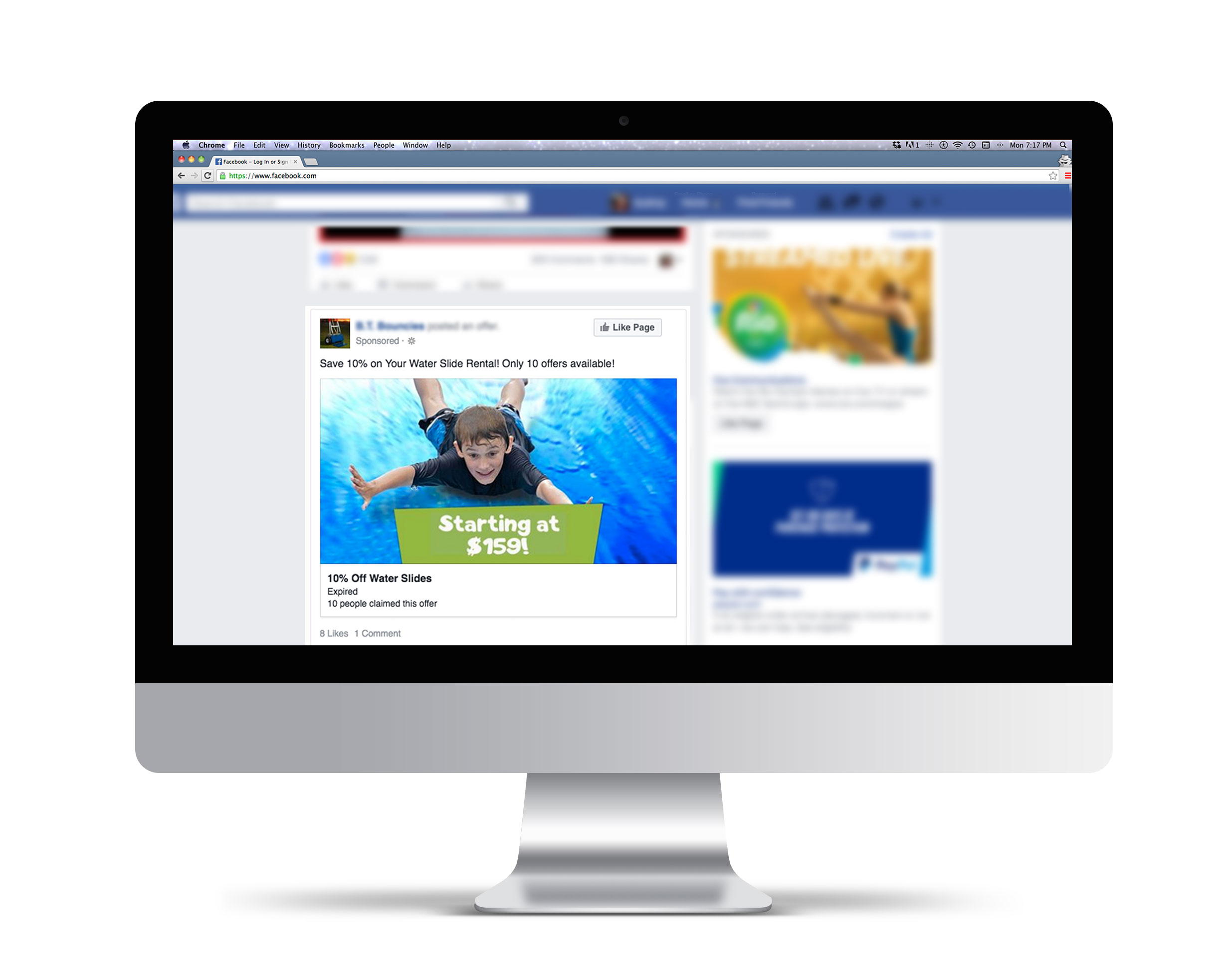Step aside Google.
You think your YouTube video ads or call-only ads are cool? You’re probably still wishing Google Wave was a thing.
My friend Facebook (ever heard of her?) is blowing my mind with her ad formats.
Lead generation? Check!
Image carousels? Check check!
Coupons to your inbox? Check check check!
Check out these 5 Facebook ad types that will blow your “can’t get a social network started” mind!
1. Facebook Carousel Ads

Carousel Ads launched back in 2014 with wild success. According to Facebook, advertisers have seen a 30-50% lower cost-per-conversion and 20-30% lower cost-per-click than traditional Facebook ads.
After using Carousel Ads for several of our clients, we definitely believe it.
Benefits of Carousel Ads
The Carousel Ad format allows you to put 3-5 images in a single ad—each with a unique link—that the reader can scroll through horizontally. This ad type is easy to set up and can be adapted for a variety of uses.
For example, one of our clients sells an online educational course. We created a Carousel Ad that featured images representing different modules offered in the course.
Carousel Ads are great for situations where you want to tell a story or showcase different aspects of a single promotion. For example, you could offer a discount code and use each image to show products that the user could use the coupon for. It’s also perfect for showing off new product lines or featuring multiple blog posts to drive traffic to your content.
Limitations of Carousel Ads
Carousel Ads will work for most businesses, but they do take a bit more preparation than single-image ads. It’s a good idea to coordinate the ad images, which might require new photography.
Also, when creating a Carousel Ad, it can be tempting to lose focus and give users very different options in each of image slots. However, this approach can overwhelm the user and cause “analysis paralysis,” so it’s most effective to use a variety of images that all support the same story or contribute to the same goal.
For instance, each image might drive to a different product, but the products are all part of the same product line. It’s also okay to repeat calls to action (CTAs), so don’t be afraid to use identical copy and destination links for each image.
2. Facebook Offer Claims
Another lesser-known ad type, Offer Claims, are a great tool for bridging the gap between digital advertising and brick-and-mortar locations. Offer Claims are essentially coupons that are shown in your target customer’s Facebook feed. When they claim the offer, they receive an email with the coupon and details on how to use it.
Benefits of Offer Claims
Offer Claims are good for attracting foot traffic because they deliver coupons for in-store purchases. For example, local restaurants could attract more first-time customers with an Offer Claim of 50% off an entrée.
Offer Claims also encourage sharing the deal with friends. One study found that this ad type received 48x more impressions than others!
Limitations of Offer Claims
The big downside to Offer Claim ads is that the advertiser does not know who’s claiming the offer. You can see how many offers have been claimed, but you don’t see any contact information. Instead, you have to wait for the individual to use the coupon. Plus, they might never redeem it.
There are ways around this, but it’s not easy. An experienced marketer like ParaCore can set up advanced tracking to gain more visibility into the people who are redeeming your offers. It’s no walk in the park, but with the right people on your team, it is possible.
3. Facebook Canvas Ads
Canvas Ads are in a league of their own. Designed to be more of an interactive experience than an ad, they offer huge flexibility for many different types of businesses.
Advertisers can choose content types such as videos, slideshows, and text blocks to show in order as the user scrolls down.
Benefits of Canvas Ads
Canvas Ads are prime tools for branding and product promotion, with truly endless possibilities. A clothing company may use it to show off their new season’s lookbook. A non-profit could talk about (and show) the impact they’re having on the community. You could use it for holiday promotions, company origin stories, or product launches.
Pretty much anything that has a story element is a great fit for Canvas Ads.
Limitations of Canvas Ads
In this case, more power comes with more work. For example, while you don’t necessarily need video, it’s a great way to make your Canvas Ad come to life. These ads also take far more thought and organization than a one-off Facebook ad. Not all businesses are prepared for the time commitment, but if they’re willing to put in the work, the results are often worth it.
4. Facebook Lead Ads

Like Offer Claims, Facebook Lead Ads, are meant for a very specific usage. In this case, they’re designed for—what else?—collecting leads.
With just two taps, a user can click the ad and submit their pre-populated contact information to you. These ads allow you to forgo creating landing pages altogether and use pop-up forms within Facebook instead.
Benefits of Lead Ads
Leads Ads should be a first choice when landing pages are too much hassle or aren’t performing as well as you hoped.
They’re most effective for higher-priced products or services, which traditionally take more trust from the buyer before they’re willing to make a purchase. All the user has to do is share a piece of contact information (which is usually pre-populated by Facebook anyway). Then, you’ll have all the information you need to send them more details about your product and close the sale.
Limitations of Lead Ads
The biggest downside to Lead Ads is their lack of notifications. Once the ad is set up, Facebook may begin collecting leads without letting you know. You have to manually check your Ad Manager regularly to make sure new leads aren’t slipping through the cracks.
Luckily, if you’re handy with code or have a marketing partner like ParaCore, you can set up a Zapier integration to automatically email you whenever a new lead comes in.
Also, since the information is pre-populated from their Facebook profile, it’s can be less-than-accurate. Be prepared to have a slightly lower lead quality with lead ads along with some incorrect phone numbers.
5. Facebook Slideshow Ads
As Facebook is expanding to developing nations, they’re trying to create more solutions to make their feed more accessible for users with slower Internet connections. Enter: Slideshow Ads. This ad type displays images with overlaid text in sequence, creating a short and simple video.
Benefits of Slideshow Ads
These ads are not only great for users who can’t download large video files, but also a powerful tool for businesses that don’t have the resources to create videos.
Facebook’s feed is now very video-heavy, and moving images are far more effective than static ones. The Slideshow Ad creation process allows you to get the results of dynamic videos, without spending time or budget creating them.
Limitations of Slideshow Ads
Unlike Carousel Ads, Slideshow Ads display multiple images without multiple CTAs. This means you can’t link to multiple products in the same ad to appeal to different viewers. And while they can be a good substitute for real videos, they still aren’t quite the same and, therefore, probably won’t produce as good of results.
Which Facebook ad types are right for your business?
We’ll help you figure it out. Our team is here to learn more about your business and design a campaign with the perfect mix of ad types to reach your goals. Sign up for a free consultation to tell us more about your company and see how we can help get the results you’ve been looking for.
Related Posts
- What Is The Difference Between PPC and SEM?
- PC Audit Handbook: How to Analyze Your PPC Campaigns
- The Best PPC Tools of 2022, As Told by PPC Experts
- Beginner’s Guide to UTM Tags & Tracking
- Generate Leads with Facebook Lead Ads
- Cost-per-click vs. cost-per-acquisition: Are you tracking the right PPC metrics?
- How Does Pay Per Click Work?
- Benefits of PPC
- Why Should I Invest in PPC?
- What is Google PPC Advertising?
- Facebook Retargeting Strategy
- Introduction to ManyChat
- Case Study: Return on Ad Spend Optimization
- 🎁🎄 Holiday Ad Spend Strategy
- Should You Be Running Branded Ads?
- SEO vs SEM
- CTAs for YouTube Ads
- Case Study: 258% Increase in Conversions
- Traffic Campaign Strategy
- No Captions on Facebook Ads or YouTube? You’re Killing Performance
- LinkedIn InMail Website Re-targeting





